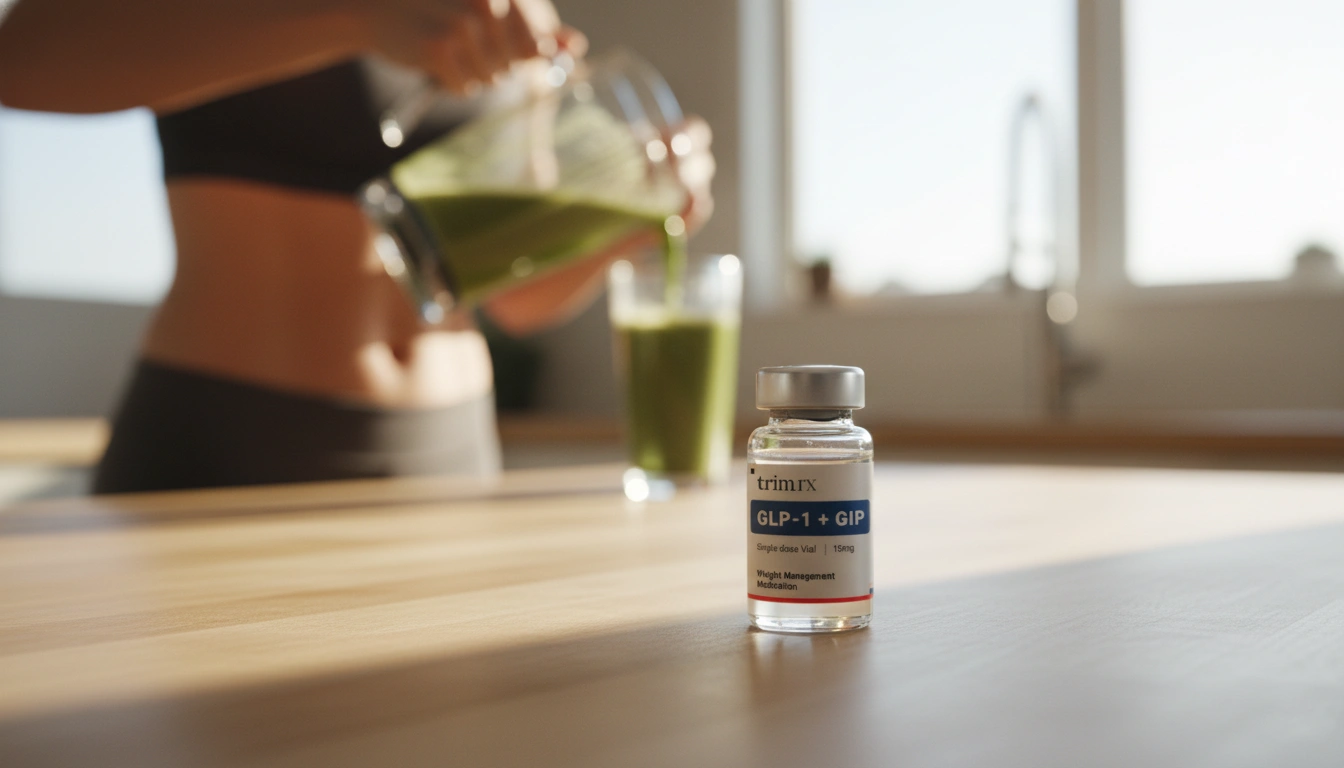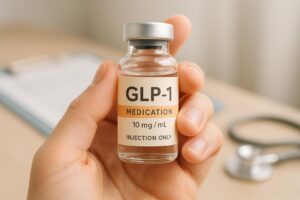Understanding the Link Between GLP-1 Receptor Agonists and Pancreatitis

Introduction
In the realm of weight management and diabetes treatment, glucagon-like peptide-1 (GLP-1) receptor agonists have emerged as game-changers. With their ability to lower blood sugar levels and facilitate weight loss, medications like Ozempic and Wegovy are gaining popularity. However, with the rise in their use comes a critical question: how does GLP-1 cause pancreatitis? This inquiry is not merely academic; it holds significant implications for patients considering these treatments.
Pancreatitis, the inflammation of the pancreas, can manifest in mild to severe forms, and its connection to GLP-1 medications has sparked considerable debate. As clinical evidence continues to evolve, understanding this potential side effect becomes essential for informed decision-making in weight loss and diabetes management.
In this blog post, we will delve into the mechanisms by which GLP-1 receptor agonists may influence the development of pancreatitis, explore risk factors, and discuss the implications for patients. By the end of our discussion, we aim to equip you with a thorough understanding of this important issue, allowing you to engage in meaningful conversations with your healthcare provider.
Together, we’ll dissect the relationship between GLP-1 medications and pancreatitis, clarify the existing uncertainties, and highlight the importance of personalized care in the context of weight loss and diabetes management.
The Mechanism of Action of GLP-1 Receptor Agonists
To comprehend how GLP-1 receptor agonists may lead to pancreatitis, it’s vital first to understand their mechanism of action. GLP-1 is a hormone produced in the intestines that plays a crucial role in glucose metabolism.
How GLP-1 Works
GLP-1 receptor agonists mimic the action of the natural GLP-1 hormone in the body. Here’s how they function:
-
Stimulating Insulin Secretion: These medications enhance insulin secretion from the pancreas in response to elevated blood sugar levels. This is particularly beneficial for individuals with type 2 diabetes, as it helps lower blood glucose.
-
Inhibiting Glucagon Release: By reducing glucagon levels—another hormone that raises blood sugar—GLP-1 receptor agonists help maintain more stable glucose levels.
-
Slowing Gastric Emptying: These drugs delay gastric emptying, which contributes to a feeling of fullness and can aid in weight loss.
-
Promoting Satiety: By enhancing feelings of fullness, GLP-1 receptor agonists can reduce overall food intake, which is advantageous for weight management.
While these actions are beneficial for managing diabetes and obesity, they also place additional stress on the pancreas, which raises questions about the potential for pancreatitis.
What is Pancreatitis?
Pancreatitis is characterized by inflammation of the pancreas, which can lead to severe abdominal pain and complications if not properly managed. There are two main types:
-
Acute Pancreatitis: This form is sudden and severe, often requiring hospitalization. Symptoms can include intense abdominal pain, nausea, vomiting, and fever.
-
Chronic Pancreatitis: This ongoing inflammation can lead to permanent damage to the pancreas, resulting in digestive issues and diabetes.
Understanding the symptoms and potential causes of pancreatitis is crucial, especially for those taking GLP-1 receptor agonists.
Symptoms of Pancreatitis
Recognizing the symptoms of pancreatitis early can be life-saving. Common symptoms include:
- Severe abdominal pain, especially in the upper abdomen
- Nausea and vomiting
- Fever and rapid pulse
- Swollen or tender abdomen
If you experience these symptoms while taking a GLP-1 medication, it’s essential to seek medical attention immediately.
The Relationship Between GLP-1 and Pancreatitis
The relationship between GLP-1 receptor agonists and pancreatitis has been a subject of ongoing research and debate. While some studies have suggested a potential link, the overall incidence of pancreatitis in patients using these medications remains low.
Clinical Evidence
Several clinical trials have investigated the incidence of pancreatitis among users of GLP-1 receptor agonists. Here are some key findings:
-
Low Incidence Rates: Most large-scale studies have not demonstrated a statistically significant increase in pancreatitis cases among patients taking GLP-1 receptor agonists compared to placebo groups. However, it is crucial to consider individual patient risk factors.
-
Risk Factors for Pancreatitis: Certain conditions can elevate the risk of developing pancreatitis while on GLP-1 medications. These include:
- History of pancreatitis: Patients with a prior history may be at heightened risk.
- Diabetes: Individuals with type 2 diabetes, particularly those with poor glycemic control, may experience higher rates of pancreatitis.
- Gallstones: The presence of gallstones can increase the likelihood of pancreatitis, and rapid weight loss associated with GLP-1 medications may exacerbate this risk.
How GLP-1 Agonists Might Trigger Pancreatitis
The exact mechanism by which GLP-1 receptor agonists may lead to pancreatitis is still not well understood. However, several hypotheses have emerged:
-
Increased Insulin Secretion: The stimulation of insulin secretion may place stress on pancreatic cells, particularly if the pancreas is already inflamed or compromised.
-
Alterations in Pancreatic Function: GLP-1 medications may cause changes in pancreatic enzyme production or secretion, potentially contributing to inflammation.
-
Gallbladder Effects: Rapid weight loss and changes in gastric emptying can lead to gallbladder issues, which in turn may increase the risk of pancreatitis.
It’s essential for patients to discuss their individual risk factors with healthcare providers before starting GLP-1 medications.
Risk Factors for Developing Pancreatitis on GLP-1 Medications
Identifying the risk factors associated with pancreatitis is crucial for those considering GLP-1 receptor agonists. Understanding these factors can help healthcare providers assess the appropriateness of GLP-1 therapy on a patient-by-patient basis.
Key Risk Factors
-
Medical History:
- Individuals with a previous diagnosis of pancreatitis may need to approach GLP-1 therapy with caution.
- A family history of pancreatitis could also increase a patient’s risk.
-
Diabetes Management:
- Poorly controlled diabetes can lead to an increased risk of pancreatitis.
-
Lifestyle Factors:
- Heavy alcohol consumption and smoking are known risk factors for pancreatitis and should be carefully evaluated in patients considering GLP-1 medications.
-
Biliary Disease:
- Existing gallstones or other gallbladder diseases can elevate the risk of acute pancreatitis in patients using GLP-1 medications.
Monitoring and Prevention
Patients starting GLP-1 receptor agonist therapy should be monitored for symptoms of pancreatitis, particularly if they have any of the aforementioned risk factors. If you’re considering a GLP-1 medication, we encourage you to complete our free assessment quiz to determine your eligibility for our personalized weight loss programs.
Take our free assessment quiz here.
Conclusion
GLP-1 receptor agonists represent a revolutionary approach to managing diabetes and obesity, but they are not without risks. Understanding the potential link between these medications and pancreatitis is vital for anyone considering their use. While the overall incidence of pancreatitis appears low, it is essential to recognize personal risk factors and engage in active monitoring.
By fostering a clear dialogue with healthcare providers, patients can make informed decisions about their treatment options. If you are exploring GLP-1 medications or seeking support in your weight loss journey, we invite you to consider our comprehensive services at TrimRx, where we focus on personalized, medically supervised care.
Additionally, for those looking for immediate support supplements, our GLP-1 Daily Support and Weight Loss Boost products are designed to enhance your weight loss journey without requiring a quiz for access.
Together, let’s navigate the complexities of weight loss and diabetes management with care and understanding.
FAQ
Can GLP-1 medications cause pancreatitis?
While there have been reports of pancreatitis associated with GLP-1 receptor agonists, the overall incidence remains low. It is crucial to evaluate individual risk factors before starting treatment.
What are the symptoms of pancreatitis?
Symptoms can include severe abdominal pain, nausea, vomiting, fever, and a swollen or tender abdomen. Seek immediate medical attention if you experience these symptoms while on GLP-1 therapy.
Who is at higher risk for pancreatitis when using GLP-1 medications?
Individuals with a history of pancreatitis, diabetes, gallstones, or those who smoke or consume alcohol may be at increased risk.
Should I stop my GLP-1 medication if I experience abdominal discomfort?
If you experience severe abdominal pain or other symptoms of pancreatitis, it is essential to seek medical advice promptly. Your healthcare provider will guide you on whether to continue the medication.
How can I manage my diabetes and weight effectively?
A comprehensive approach involving lifestyle changes, a balanced diet, and possibly medications, in consultation with a healthcare provider, can help you manage diabetes and support weight loss.
For personalized support and to explore our GLP-1 medications, consider taking our free assessment quiz today!

Transforming Lives, One Step at a Time
Keep reading
Tracking Progress With GLP-1: What To Measure
Learn which metrics to track on GLP‑1 therapy—weight, waist, blood sugar, lipids, side effects, and non‑scale wins—and how often to monitor them.
Fatigue Solutions for Ozempic and Wegovy Users
Hydration, protein-rich meals, light activity, and better sleep can reduce medication-related fatigue and help maintain energy during weight-loss treatment.
GLP-1 Medication Side Effect Checker
Worried about GLP-1 medication side effects? Use our free checker for Semaglutide, Liraglutide, and more to learn what to expect and stay informed!



